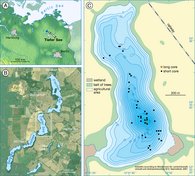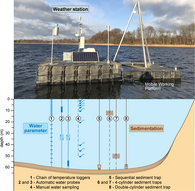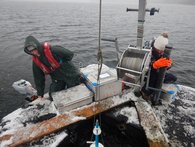Since 2012 we run a comprehensive lake sediment monitoring at Lake Tiefer See in the NE German lowlands within the TERENO (Terrestrial Environmental Observatories) initiative of the Helmholtz Association and the BaltRap project. The goals of this project are twofold:
- deciphering seasonal sedimentation processes and controlling factors (climate conditions and human impacts).
- observing regional and local impacts of ongoing global change.
Decoding of sedimentation processes is essential for the interpretation of proxy data from long sediment records for reliably reconstructions of past climate changes.
Why Tiefer See?
We have selected Tiefer See for the monitoring because it presently forms annually laminated sediments (varves) allowing us to decipher seasonal sedimentation at great detail.
Tiefer See is located in the northeastern corner of the Natural Park Nossentiner-Schwinzer Heide. With ca 62.5 m maximum depth it is the deepest lake of the Klocksin lake chain that formed as subglacial channel during the last glaciation. Tiefer See is located close to the Pomeranian Ice margin (W2 moraine) and the catchment is formed by glacial till. After melting of the ice sheet in this region the lake basin was filled with dead ice for several thousand years until the lake formed in the late Allerød ca 13 000 years ago. Organic-dominated sedimentation abruptly commenced with the warming at the onset of the Holocene 11 600 years ago.
Tiefer See specifications
Coordinates: 53° 36' N / 12° 32' E
Elevation above sea level: 63 m
Maximum depth: 62.5 m
Lake area: 75 ha
Lake volume: 14 x 106 m3
Catchment area: 5.5 km2
Monitoring setup
Our monitoring setup includes (1) a permanent weather station on the lake, (2) lake water observation, (3) sediment trapping, and, (4) regular sampling of short sediment cores from different parts of the lake basin.
(1) The weather station is mounted on a floating platform which is permanently anchored in the deepest part of the lake basin. We measure air temperature and pressure, precipitation global radiation, photosynthetically active radiation (PAR), wind direction and speed, all at 10 min time resolution. In addition, we collect rain water and dust mounted on the platform. Rain water is analysed in monthly intervals for δD und δ18O isotopes.
(2) Lake water monitoring: with two parallel automatic water probes we measure at 12-hour resolution water temperature, pH, conductivity, turbidity, oxygen content, redox potential and chlorophyll every meter down to 55 m water depth. In addition, permanent loggers are installed for temperature measurements every 6 hours with 1 m-spacing down to 12 m water depth and 5 m-spacing down to 55 m. In monthly intervals, we manually measure secchi depth and take water samples at 1, 3, 5, 7, 20, und 50 m for δD and δ18O analyses. Lake water samples are filtered for solid particles at 1, 3, 5, 7, 10, 20, and 50 m water depth.
(3)Sediment trapping: We have installed three different types of sediment traps at different water depths and time resolution. A sequential trap at 50 m water depths samples sediments in 15-day intervals. A parallel double-cylinder trap at the same water depths as backup integrates sediment samples over 6 months. Two additional 4-cylinder traps at 12 and 50 m water depth collect sediment samples in monthly intervals. From sediment samples in all traps we determine total carbon (TC), total organic carbon (TOC), total nitrogen (TN), calcium carbonate (CaCO3), and δ13Corg, δ15N, δ13Ccarb und δ18Ocarb isotopes. The 4-cyclinder trap at 50 m water depth is additionally analysed for sedimentary DNA from cyanobacteria.
Publications
- Brauer, A., Heinrich, I., Schwab, M. J., Plessen, B., Brademann, B., Köppl, M., Pinkerneil, S., Balanzategui, D., Helle, G., Blume, T. (2022): Lakes and trees as climate and environment archives: the TERENO Northeastern German Lowland Observatory. - DEUQUA Special Publications, 4, 41-58. https://doi.org/10.5194/deuquasp-4-41-2022
- Nwosu, E.C., Brauer, A., Kaiser, J., Horn, F., Wagner, D., Liebner, S. (2021a). Evaluating sedimentary DNA for tracing changes in cyanobacteria dynamics from sediments spanning the last 350 years of Lake Tiefer See, NE Germany. Journal of Paleolimnology, 66: 279–296. | doi:10.1007/s10933-021-00206-9
- Nwosu, E.C., Roeser, P., Yang, S., Ganzert, L., Dellwig, O., Pinkerneil, S., Brauer, A., Dittmann, E., Wagner, D., Liebner, S. (2021b). From Water into Sediment – Tracing Freshwatrer Cyanobacteria via DNA Analyses. Microorganisms, 9: 1778. | doi:10.3390/microorganisms9081778
- Nwosu, E.C., Roeser, P., Yang, S., Pinkerneil, S. Dittmann, E., Brauer, A., Wagner, D., Liebner, S. (2021c). Species-Level Spatio-Temporal Dynamics of Cyanobacteria in a Hard-Water Temperate Lake in the Southern Baltics. Front. Microbiol., 12:761259. | doi:10.3389/fmicb.2021.761259
- Theuerkauf, M., Blume, T., Brauer, A., Dräger, N., Feldens, P., Kaiser, K., Kappler, C., Kästner, F., Lorenz, S., Schult, M. (2021) Holocene lake-level evolution of Lake Tiefer See, NE Germany, caused by climate and land cover changes. Boreas. ISSN 0300-9483 | doi:10.1111/bor.12561
- Roeser, P., Dräger, N., Brykała, D., Ott, F., Pinkerneil, S., Gierszewski, P., Lindemann, C., Plessen, B., Brademann, B., Kaszubski, M., Fojutowski, M., Schwab, M.J., Słowiński, M., Błaszkiewicz, M., Brauer, A. (2021). Advances in understanding formation of calcite varves: new insights from a dual lake monitoring approach. Boreas. | doi:10.1111/bor.12506
- Nantke, C.K.M., Brauer, A., Frings, P.J., Czymzik, M., Hübener, T., Stadmark, J., Dellwig, O., Roeser, P., Conley, D.J. (2021). Human influence on the continental Si budget during the last 4300 years: δ30Sidiatom in varved lake sediments (Tiefer See, NE Germany). Quarternary Science Reviews 258: 106869. | doi:10.1016/j.quascirev.2021.106869
- Dräger, N., Plessen, B., Kienel, U., Słowiński, M., Ramisch, A., Pinkerneil, S., Brauer, A. (2019). Relation of δ13C of sedimentary organic matter and varve preservation in the sediment record of Lake Tiefer See (NE Germany). Journal of Paleolimnology, 62:181–194. | doi:10.1007/s10933-019-00084-2
- Czymzik, M., Muscheler, R., Adolphi, F., Mekhaldi, F., Dräger, N., Ott, F., Słowinski, M., Błaszkiewicz, M., Aldahan, A., Possnert, G., Brauer, A. (2018). Synchronizing 10Be in two varved lake sediment records to IntCal13 14C during three grand solar minima. Clim. Past, 14, 687–696. https://doi.org/10.5194/cp-14-687-2018
- Heinrich, I., Balanzategui, D., Bens, O., Blasch, G., Blume, T., Böttcher, F., Borg, E., Brademann, B., Brauer, A., Conrad, C., Dietze, E., Dräger, N., Fiener, P., Gerke, H.H., Güntner, A., Heine, I., Helle, G., Herbrich, M., Harfenmeister, M., Heußner, K.-U., Hohmann, C., Itzerott, S., Jurasinski, G., Kaiser, K., Kappler, C., Koebsch, F., Liebner, S., Lischeid, G., Merz, B., Missling, K.D., Morgner, M., Pinkerneil, S., Plessen, B., Raab, T., Ruhtz, T., Sachs, T., Sommer, M., Spengler, D., Stender, V., Stüve, P., Wilken, F. (2018). Interdisciplinary Geo-ecological Research across Time Scales in the Northeast German Lowland Observatory (TERENO-NE). Vadose Zone Journal. | doi:10.2136/vzj2018.06.0116
- Kienel, U., Kirillin, G., Brademann, B., Plessen, B., Lampe, R., Brauer, A., (2017). Effects of spring warming and mixing duration on diatom deposition in the deep Tiefer See, NE Germany. Journal of Paleolimnology 57, 37–49. | doi:10.1007/s10933-016-9925-z
- Dräger N, Theuerkauf M, Szeroczyńska K, Wulf S, Tjallingii R, Plessen B, Kienel U, Brauer A (2017) A varve micro-facies and varve preservation record of climate change and human impact for the last 6000 years at Lake Tiefer See (NE Germany). The Holocene 27: 450–464. | doi:10.1177/0959683616660173
- Heine, I., Brauer, A., Heim, B., Itzerott, S., Kasprzak, P., Kienel, U., Kleinschmit, B. (2017). Monitoring of calcite precipitation in hardwater lakes with multi-spectral remote sensing archives. Open Access Journal Water 9, 15 | doi:10.3390/w9010015
- Czymzik, M., Muscheler, R., Brauer, A., Adolphi, F., Ott, F., Kienel, U., Dräger, N., Słowiński, M., Aldahan, A., Possnert, G. (2015). Solar cycles and depositional processes in annual 10Be from two varved lake sediment records. Earth and Planetary Science Letters 428, 44-51. | doi:10.1594/PANGAEA.848364
- Theuerkauf M, Dräger N, Kienel U, Kuparinen A, Brauer A (2015) Effects of changes in land management practices on pollen productivity of open vegetation during the last century derived from varved lake sediments. The Holocene 25: 733–744. | doi:10.1177/0959683614567881
- Kienel, U.; Dulski, P.; Ott, F.; Lorenz, S.; Brauer, A. (2013): Recently induced anoxia leading to the preservation of seasonal laminae in two NE-German lakes. Journal of Paleolimnology, 50/4, 535-544. | doi:10.1007/s10933-013-9745-3







